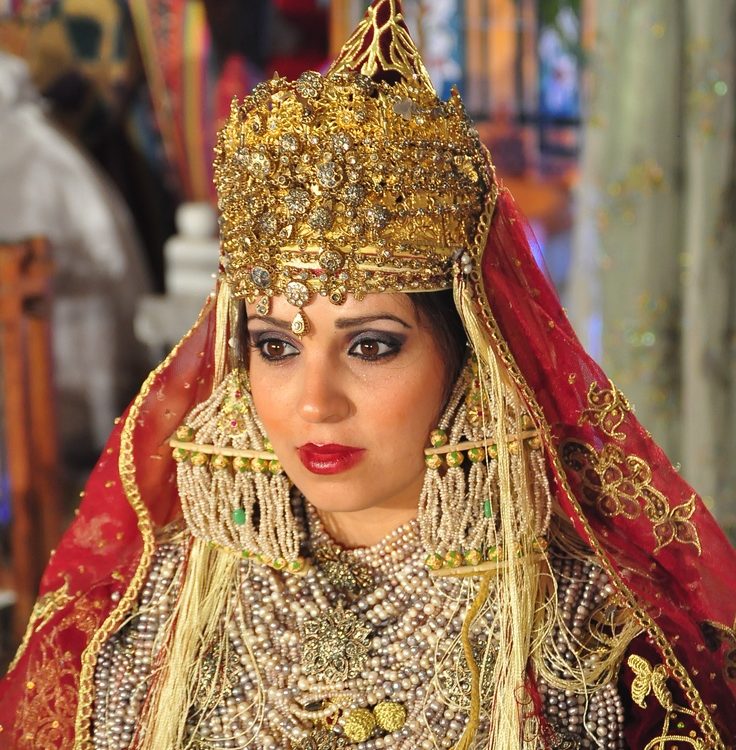By Naila Missous.
The story of Algerian jewellery dates back to prehistoric times. Fine examples have been dug out from the soil, and time and history has revealed the complex craftsmanship and detail that is rooted in the antiquity of Algerian jewellery.
Islamic heritage has played a great part, and has been an important determining factor in the story of the development of the Algerian arts and crafts. The advent of Islam in North Africa was to engulf the old civilisations of Rome and Byzantine, and would introduce a new light of inspirational expression, eliminating graphic representations inspired of human and animal forms, advantaging a different set of concepts.
The cultural imprint on each of the jewellery designs in Algerian jewellery all tell a tiny piece of history; claiming an era throughout Algeria’s extensive past. One can see examples of Roman, Ottoman and Spanish design in the fine necklaces and pendants, as well as Amazigh and Arab.
Due to the inspiration of sources, the jewellery adorned is a living testimony of an old age creative force. Historically, Algiers, Tlemcen and Constantine were vibrant jewellery centres, with shop upon shop offering custom made as well as traditional arrangements.
Algerian women usually adorn the various styles of jewellery in modern times when wearing traditional outfits. Each wilaya (province) of Algeria has customs and traditions when it comes to clothing and jewellery. The modern Algerian women will usually wear these on special occasions such as Eid or a wedding, however many are finding modern interpretations and incorporating them into their everyday outfits.
With such a variety of jewellery to choose from, below I have selected four styles from different regions of Algeria and explained them.
1- Kabyle jewellery:
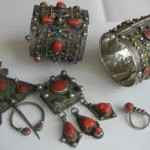 The Kabyles are an Amazigh group predominantly located in the Kabylia region in the north of Algeria, though of course many have dispersed to other cities. The Kabyle’s are famous for their silver jewellery, which is then painted with plenty of colour: also matching their traditional dress. The silver is produced through a glazing technique and was first introduced in the 15th Century. They made necklaces, headpieces, pendants, earrings and even anklets that come in a variety of styles, yet all have the unique Kabyle features which highlights it from the rest.
The Kabyles are an Amazigh group predominantly located in the Kabylia region in the north of Algeria, though of course many have dispersed to other cities. The Kabyle’s are famous for their silver jewellery, which is then painted with plenty of colour: also matching their traditional dress. The silver is produced through a glazing technique and was first introduced in the 15th Century. They made necklaces, headpieces, pendants, earrings and even anklets that come in a variety of styles, yet all have the unique Kabyle features which highlights it from the rest.
2: Chaoui jewellery:
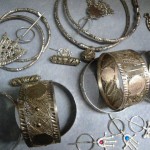 Like the Kabyles, Chaoui’s are also an Amazigh group, mainly living in east Algeria. Tradition is one of the main components for Chaoui jewellery, opting for plain silver but a lot more detailed engraving. Not only do they create necklaces and earrings, but also extremely intricate head and forehead pieces which are not only worn for weddings, but on a day-to-day bases. The necklaces also can be very heavy and ornate, with various chains hanging.
Like the Kabyles, Chaoui’s are also an Amazigh group, mainly living in east Algeria. Tradition is one of the main components for Chaoui jewellery, opting for plain silver but a lot more detailed engraving. Not only do they create necklaces and earrings, but also extremely intricate head and forehead pieces which are not only worn for weddings, but on a day-to-day bases. The necklaces also can be very heavy and ornate, with various chains hanging.
3: Touareg jewellery:
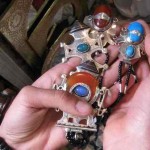 The Touaregs live mainly in the Sahara desert of Algeria. This jewellery is linked greatly to mythical traditions of the Tuareg, which has been preserved to this day. The Tuareg are keen advocates of craftsmanship and using one’s hands to be creative, and thus jewellery is a great outlet for this, man or woman. The main inspiration draws from natural elements that surrounds them. Pendants, rings, pectorals, earrings, anklets, brass rings, and shell necklaces are all loyal representations of a bygone era.
The Touaregs live mainly in the Sahara desert of Algeria. This jewellery is linked greatly to mythical traditions of the Tuareg, which has been preserved to this day. The Tuareg are keen advocates of craftsmanship and using one’s hands to be creative, and thus jewellery is a great outlet for this, man or woman. The main inspiration draws from natural elements that surrounds them. Pendants, rings, pectorals, earrings, anklets, brass rings, and shell necklaces are all loyal representations of a bygone era.
4: Tlemcen jewellery:
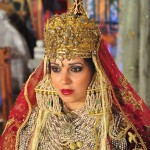 The element of jewellery in the west of Algeria originates from the town of Tlemcen, the capital of the eponymous wilaya.
The element of jewellery in the west of Algeria originates from the town of Tlemcen, the capital of the eponymous wilaya.
Tlemcen’s cultural heritage is rooted in Amazigh, Roman, Arab, Andalusian and Ottoman cultures. Named the capital of central Maghreb (present Algeria), and following the rise of the Zianide Kingdom in the thirteenth century, Tlemcen yielded its capital status to Algiers in the sixteenth century, but remained one of t!he most prestigious cultural centres of the Maghreb.
The feminine wedding costume embodies the main festive event of the Tlemcen community. It symbolises the alliance between the families and continuity between generations, jewellery playing a big role. Countless rows of baroque pearls protect her vital and reproductive organs against evil spirits. To leave the home of her parents, she is covered with a veil of flamboyant silk, a legacy from Amazigh-Roman nuptial rites. Ontop of this, she is adorned with gold headdresses, earrings and bracelets. The main instruments for the creation of Tlemceni jewellery is gold and pearls.
Naila is a writer with an interest in Algeria, North Africa and the Middle East. She is also translator of Arabic, French and English.

